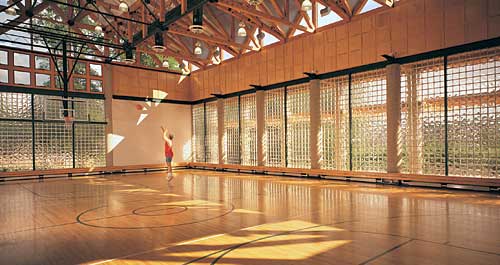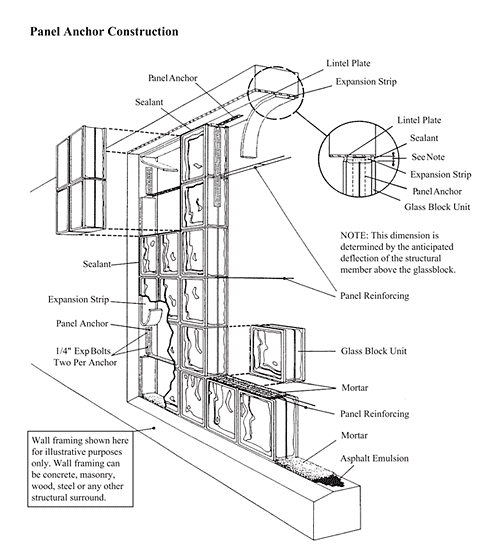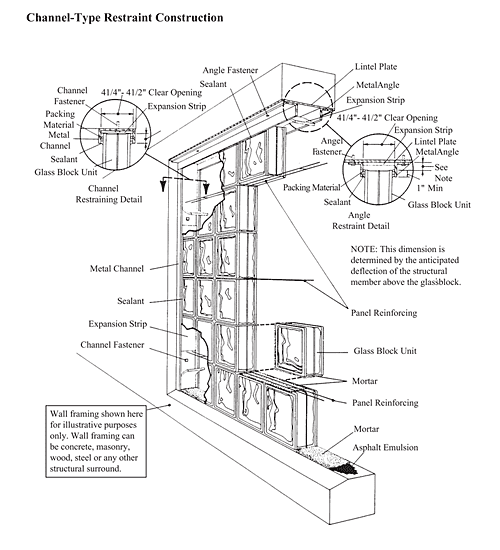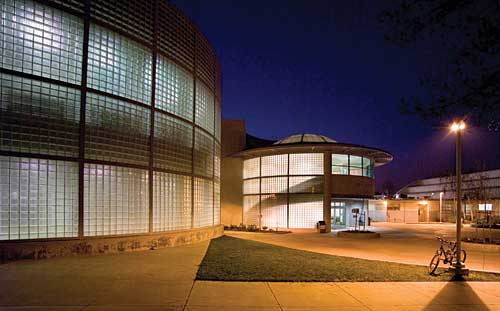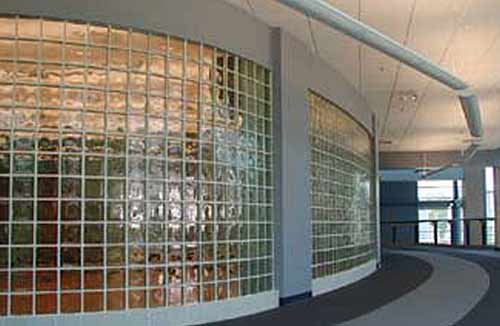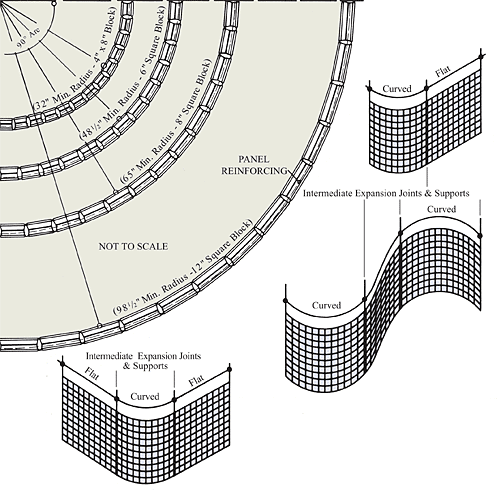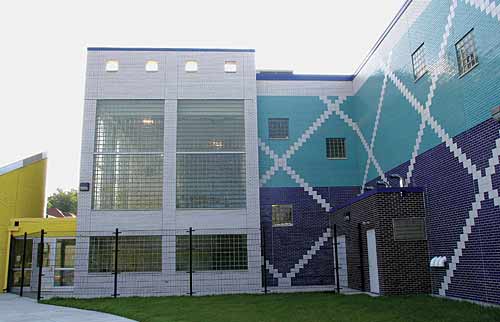Designing With Glass Block: Abundant Applications Provide Practical, Aesthetic and Green Solutions
![]() Continuing Education
Continuing Education
Use the following learning objectives to focus your study while reading this month’s Continuing Education article.
Learning Objectives - After reading this article, you will be able to:
- Identify the structural properties of glass block when used as a building material.
- Discuss the unique performance abilities of glass block, such as fire protection, heat and light transmission, sound resistance, vandal resistance, and hurricane and earthquake resistance.
- Assess some of the economic and aesthetic implications of specifying glass block in specific building projects.
Glass block is a unique building material. It has a dynamic relationship with light-both natural and artificial. As light changes so do the material's appearance and the surrounding environment. A great range of light and privacy is available depending on the pattern and transparency of the glass block. Used creatively, this building material can produce dramatic aesthetic effects.
The transparency of light depends on the pattern of glass block used. The results range from maximum light transmission to increasing degrees of privacy. Even with the most opaque block, or when using glass blocks as accent pieces, the result is the same--a visual connection from inside to out, or connecting to inside spaces. This sensory stimulant offers more than just aesthetics--it is considered a necessary component of a psychological and physiological healthful living and working environment. This brick made of glass also provides energy efficiencies, sound control, security and even visual texture. Today, with the growing commitment to green building, its properties and benefits may contribute to U.S. Green Building Council (USGBC) LEED® (Leadership in Energy and Environmental Design) certifications.
Glass block can be used in residential as well as commercial projects, as non-load bearing walls, windows, or partitions. An astonishing range of applications is possible with a corresponding variety of aesthetic results. Glass block have been used in police stations, subway terminals, schools, parking garages and gymnasiums, in addition to numerous private and commercial new construction and renovations. Consider some interior uses: as a contemporary shower stall, a kitchen island or backsplash, or as the sidelights at the front door. Yet, before building aesthetics and even design can be considered, it is crucial to become familiar with the technical properties of glass block. Working with glass block requires a certain level of skill and a thorough understanding of the material.
Structural Properties
Glass block is manufactured through a simple, yet exacting process. Silica sand, soda ash, and limestone are mixed and melted in tanks heated to 2,300 degrees Fahrenheit. From those tanks a precise amount of molten glass is poured into a half-block mold. Two halves are sealed together, creating a partial vacuum within the unit, and then fed into an oven (called a lehr) to slowly cool and, in the process, strengthen. This is the annealing process. Each block is then treated with a special edge coating of polyvinyl butyral to increase mortar bond and allow for expansion and contraction. Each block is tested for clarity and consistency.
Â
Â
Â
|
Â
The unit can be hollow or solid and come in a variety of sizes, shapes, patterns, and textures. The most commonly used units are square (6-, 8-, or 12-inch sizes). Rectangular units (4x8-inch and 6x8-inch) are also available, as are bull-nosed edge blocks for finishing horizontal and vertical panels, and various corner and angular blocks.
What makes the choice of block all the more interesting is the wide range of patterns. Clear block with its smooth face offers high visibility and light transmission. Wavy and fluted patterns allow for moderate levels of visual privacy while maintaining high light levels. Even greater privacy comes with stippled, diamond, and tightly ribbed designs. Fibrous glass inserts are also available to provide maximum privacy and further temper light and heat transmission.
Since glass block is made of glass and typically bonded together with mortar, it does not require any maintenance or special care. The durability is therefore exceptional because of the thickness of the faces and mortar bonding of the blocks. Unlike a typical glazing system or window, whereby the whole glass pane requires replacement upon damage, breakage in a glass block wall or window typically only requires a single block replacement. Many installations are over 50 years old, well beyond the typical life cycle of a window. This represents a considerable savings in material and maintenance.
Â
Generally, two thicknesses are available. The standard 3-7/8-inch glass block includes the largest selection of patterns, sizes and shapes. Each 3-7/8-inch thick glass block is designed to provide stability and durability, as well as good insulation values, sound transmission, and fire resistance ratings. Thinner 3-1/8-inch block is specifically designed for prefabricated panels of limited size, for use as windows.
In exterior applications, maximum wall areas are based on design wind pressure. Twenty pounds per square foot is a commonly accepted value for wind load resistance for wall construction. The maximum area for exterior panels constructed of standard block is 144 square feet, with a maximum height of 20 feet or a maximum width of 25 feet. This panel is designed to withstand a 20 psf wind load-equivalent to about an 88-mph wind-with a 2.7 safety factor. If larger panels are required, horizontal and/or vertical stiffeners or shelf angles and expansion joints need to be incorporated to maintain the maximum areas recommended per component panel. Design of these structural members must be based on the design wind load and to an L/600 deflection (where L equals the distance between supports).
Interior walls are designed to a lateral load of 5 psf. Interior glass panels are permitted to be larger (up to 250 square feet) than similar exterior panels because of the lower load levels.
Non-load bearing. Sometimes referred to as "bricks," glass blocks do not have the load-bearing capabilities as do other masonry products. In fact, glass block can only carry the load of its own weight. Therefore, where panels are inserted into openings, provisions must be made to support the construction above. The available structural support systems assure that the load from the surrounding wall is not transferred to the glass panel and that the possible deflection of the supporting members does not crack the panel.
At the same time, adequate provisions must be made for differential movement between the glass and the surrounding wall. It is recommended that expansion joints in the surrounding wall be located at the sides and top of each glass panel. This will isolate the panel and prevent a movement crack in the wall from projecting through the glass panel.
Mortar considerations. Unlike other masonry products (i.e., brick, concrete block, etc.), glass block is non-porous and does not absorb any moisture. Because of this, the consistency of glass block mortar must be stiffer (like peanut butter) than the wetter mortar used with other masonry products. All head and bed joints must be completely filled with mortar, and all joints struck smooth to prevent penetration and migration of moisture.
All model building codes allow the use of Type "S" or "N" mortar with glass unit masonry construction. Type "S" mortar is recommended for exterior applications. Type "S" consists of 1 part Portland cement, 1/2 part lime, and sand equal to 2-1/4 to 3 times the amount of cementitious material (cement plus lime), all measured by volume. (For exterior glass block panels, an integral type waterproofer is recommended.) No antifreeze compounds or accelerators should be used.
During final cleaning, common mortar-removing chemicals (muriatic acids of any strength) should not be used. Not that these chemicals are detrimental to glass; however, if they are strong enough to remove mortar off the faces of the block, they are also strong enough to remove the thin cement/lime film off the mortar joints, thereby exposing the sand aggregate. Rough joints such as these are highly susceptible to water intrusion.
Â
Â
|
Â
Panel reinforcement. Horizontal joint reinforcement is important to control cracking due to expansion and contraction. This joint reinforcement should be spaced no more than 16 inches on center and extend horizontally the length of the panel. Stainless steel or hot-dipped, galvanized, 9-gauge steel, ladder-type reinforcement is made of two parallel wires with butt-welded cross wires at regular intervals.
Joint reinforcement should also be placed in the bed joint immediately above and below openings in the glass block panel. For curved walls, the inner wire is cut periodically so the reinforcement can be bent to the radius of the curve. The reinforcement is pressed into the partially filled mortar joint, then covered with the remaining mortar and trowelled smooth. Mortar joints should not be furrowed.
Expansion strips, made of dense fibrous glass, polyethylene, or mineral wood replace mortar at the jambs and head and at intermediate structural locations to allow for panel expansion and contraction.
Â
Panel anchoring. Three methods for anchoring glass block panels are recommended to accommodate lateral support along the top and sides of each panel - panel anchor, channel, and chase systems. These supports are designed to resist the applied loads, or a minimum of 200 pounds per lineal foot of panel, whichever is greater.
Panel anchors: Available in stainless steel or hot-dipped galvanized steel, panel anchors tie glass block panels into the surrounding frame at head and jamb locations. Anchors are used along the jambs and at the head, or they can be used in combinations with channel construction where one type of detailing is at the jambs and the other at the head. Anchors are normally placed a maximum of every 16 inches on center. This means that for an 8 x 8-inch block, panel anchors would be placed in every other course.
Channel framing: Either a metal channel or metal angles combined to form a channel can be used. The channel opening (for a nominal 4-inch-thick block) must be 4-1/4 inches to 4-1/2 inches wide by a minimum of 1-3/8 inches deep to allow for a 1-inch minimum recess of glass block into the channel and for placement of the expansion material inside the channel. It is critical that the channel opening be square, not tapered as in standard channels, so as not to pinch the edges of the glass block. The oversized opening allows the insertion of packing material and sealant between the recessed faces of the glass block and channel legs.
Chase method: A recessed chase can be inserted into concrete or masonry jambs and head, eliminating the need for anchors or metal channels. The dimensions described must be similar to those described above for metal channels.
Â
Â
|
Â
Expansion joints. To accommodate movement of the glass, expansion strips 3/8-inch thick, are required along the top and sides of glass block panels. These joints are filled with a resilient material such as polyethylene, which allows the panel to expand and contract. In exterior walls, joints must be well caulked to prevent water penetration.
At the bottom of the opening, a water-based asphalt emulsion is placed on the sill prior to laying the first mortar bed. This provides a slip plane for the panel and also prevents water from being drawn out of the glass block mortar by absorbent sill materials, such as concrete, brick, wood, or other porous products.
Curved walls. Curved panels require additional structural support where the curved section joins a straight section and at inflection points in multi-curved walls. One method is to connect the panel to a structural member with panel anchors. Installing a steel plate in a vertical head joint can provide a less visible support. Also, panel reinforcing should be modified to follow the contour of the curve by periodically cutting the innermost parallel wire and bending appropriately.
The inside minimum radius of a curved wall is influenced by the size of block being used. Creating a tighter curve means creating a thinner inside joint, which is not recommended, and a thicker outside joint, which may not be aesthetically pleasing.
Health, Saftey and Environmental Benefits
The unique properties of glass block are especially applicable to health and safety issues, in addition to providing a number of environmental advantages. They offer special performance characteristics regarding fire resistance; resistance to surface condensation, light, heat, thermal and shading performance; sound transmission; and hurricane and earthquake resistance. Equally significant is the potential role in green building and contribution to several categories in LEED certifications-both in quantifiable and qualitative measures.
Green building now includes far more than data and performance of building products. Occupants' comfort and well-being and factors such as daylight are critically important for Green Building-especially when designing for the unique needs of children of all ages. Another factor in Green Building is life cycle analysis, which quantifies the impact of a product or building from raw materials used through its disposal or reuse. While life cycle analysis is, as yet, hard to quantify, it is certainly an issue to consider when specifyng green products. Glass block has the advantage of having a relatively low life cycle impact, being both recyclable and manufactured from unlimited natural resources. Moreover, being 100 percent glass, it does not emit any harmful volatile organic compounds (VOCs).
Â
Â
Fire-protection. Presently, no glass block assemblies qualify as fire-rated wall assemblies. Unlike the wall assembly test that measures a material's integrity, stability and thermal transmission, the glass block window test only determines the ability of the assembly to remain structurally sound and prevent passage of smoke and other noxious fumes during the fire test. Therefore, all assemblies must meet standards set for windows (ASTM E-2010) and NFPA 257) rather than for walls (ASTM E-119).
All UL fire-rated glass block on the market meets a 45-minute or longer duration test. Thicker faced and solid units are available with ratings of 60 minutes and 90 minutes. Basically, the window assembly test consists of exposing a panel to a fire under controlled temperature conditions in a furnace. The panel is removed from the furnace after 45 (or 60 or 90) minutes and immediately subjected to a standard water hose steam test to determine impact and thermal shock effects. A glass block window assembly passes the hose stream test if at least 70 percent of its glass blocks do not develop openings through both faces of the block.
Â
Â
|
Â
Â
Â
|
Â
Â
|
Â
Â
For curved construction, 45-minute fire ratings can be obtained provided that the maximum allowable curvature does not exceed a ratio of 2:1 with respect to length of radius to length of assembly width (i.e., chord length), and only installed within masonry fire-rated walls.
Surface condensation. Resistance to surface condensation is considered impressive for hollow glass block because of the double face and partial vacuum construction of hollow glass block. In fact, standard glass blocks are considered condensation-free to minus 15 degrees Fahrenheit and thin blocks to minus 8 degrees Fahrenheit. This compares to a single-glaze flat glass, for which condensation can occur when the exterior temperature reaches 33 degrees Fahrenheit.
Â
Â
Â
|
Â
Light and heat transmission.The light transmission in glass block is nearly equal to that of flat glass. For example, the following figures apply to light transmission:
- Flat sheet glass-90 percent of visible light that strikes is transmitted
- Solid glass block-80 percent is transmitted
- Standard and thin block-75 percent is transmitted
- Tightly ribbed patterns-50 percent is transmitted
- Fibrous glass inserts and thick-faced block-50 percent to 55 percent is transmitted
The thickness and whether the block is hollow or solid affect the heat transmission value (U-value):
- Sheet glass-U-value = 1.04
- Solid glass block-U-value = 0.87
- Thin block-U-value = 0.57
- Standard block-U-value = 0.51
Thermal resistance, or R-value, is the inverse of U-value. The solid glass block R-value is 1.15. With hollow glass block and its inherent partial vacuum, a jump in R-value occurs: The R-value of thin glass block is 1.75 and the R-value of standard glass block is 1.96.
The differences between the shading coefficient of glass block and flat sheet glass is significant. Thin glass block can reduce the shading coefficient of 1.00 for 1/8-thick flat sheet by 35 percent to 0.65 (and down to 0.45 for tightly ribbed patterns). Contributing to this, experts say, is the louvering effect of glass block's horizontal mortar joints, which helps reduce light transmission from the higher sun. The size and orientation of the block can, therefore, affect the amount of shading that occurs.
Â
Â
|
Â
Â
Sound transmission. Sound transmission class (STC) is a rating that provides an estimate of the sound-absorbing performance of the partition for general building design purposes. The rating is designed to correlate with subjective impressions of the sound insulation provided against the sound of speech, radio, television, music and similar sources of noise in offices and dwellings. STC value represents an average of sound transmission losses between the 125 Hz and 4,000 Hz frequencies.
The sound-reducing characteristics of glass block are most notable in the hollow block with its partial vacuum (35 STC to 40 STC). With thick-faced and solid block, the STC is 48 and 53, respectively. This compares with about 29 STC for flat sheet glass (1/8-inch thick), 45 STC for single width 4-inch brick wall and 50 STC for 6-inch solid concrete masonry unit wall system. Because of this feature, coupled with other properties, the NYC Transit Authority uses this product throughout their transit systems.
Impact resistance. Glass blocks are inherently stronger than conventional glass because of the thickness of the faces and the mortar that binds the blocks together. As a result, glass blocks are more difficult to break and, therefore, provide resistance and are a deterrent to forced entry and vandalism.
Â
Â
|
Panel sizes and design pressures relating to Dade County High Missile Impact Tests.
Â
Â
Solid 3-inch glass block units provide the greatest resistance to breakage and are ballistics-tested and qualified to UL levels 1, 2 and 6. Even greater resistance to forced entry can be achieved by using metal grid systems that accommodate the solid units. In the case of mortared systems, single blocks can be replaced at minimal expense compared to conventional glass, which requires replacement of the full pane or panel.
Hurricane resistance. Research following the devastation of Hurricane Andrew-the second most costly catastrophe in the U.S. after Hurricane Katrina-found that the most significant hurricane damage was from wind-blown debris made up of building parts. Studies also found that the most decisive cause of building frame collapse was the failure of doors and windows. Miami-Dade and Broward Counties consequently implemented changes in the Building Code relating to glazing systems. Many states have since adopted hurricane code requirements.
Hurricane-resistant glass block has a greater face thickness than standard glass block. It meets large missile tests referenced in the International Building Code in accordance with ASTM E-1886 and ASTM E-1996.
Earthquake resistance. Glass block panels inherently have two attributes that make them safe in earthquakes. One is their rigidity relative to a tall building's rigidity. When used in tall buildings, the glass block panels experience earthquake motions that cycle back and forth very slowly relative to the vibration frequency of the glass block. Thus, the glass block's ride during an earthquake is a smooth ride. The building acts like the soft shock absorbers in cars that soften passengers' ride from the irregular imperfections in the road.
The second attribute of the glass block is the rigidity of the glass block panel relative to the rigidity of short buildings or residences. The critical vibration frequency is greater than the more severe vibration frequency of the earthquake ground shaking. Therefore, the g-forces from the earthquake are not amplified or turned into the ground motion as other architectural items, such as chandeliers or bookshelves.
Lighting Design Considerations
Glass block has a dynamic relationship with both natural and artificial light. The affect of artificial light on glass block can vary dramatically with the type and intensity of light and the pattern of the glass block. In architectural applications, halogen, incandescent and fluorescent light sources are the most commonly used.
- In order to evenly light a glass block, use a "wall washing" technique by placing the light source 12 inches to 18 inches in front or behind the panel. Keep the light source parallel to the face of the panel in horizontal or vertical configurations.
- Using a "spotlight" technique of focusing directly on the glass block panel, the sidewalls and mortar will absorb the light differently from the central portion of the panel, thus producing an uneven look. To ensure an even lighting effect, place the light sources evenly every 12 inches to 18 inches along the ceiling or side walls.
- Curved or angular panels require both horizontal and vertical light fixture placements. When combining different types of light sources, the use of the same color spectrum will bring a more uniform effect. Alternatively, different colored lights can produce special effects.
- Neon tube lighting placed behind a glass block panel can create special "hot spots." For more even lighting, neon tubes may be placed directly behind the mortared course lines or along a panel's perimeter.
Â
Â
|

